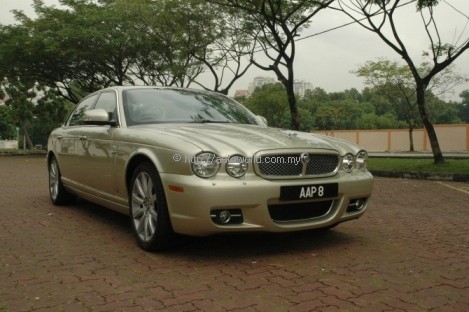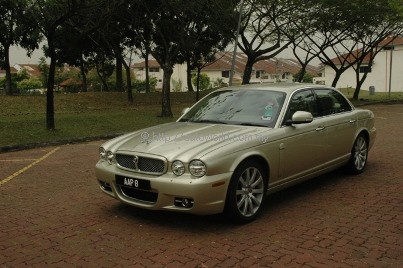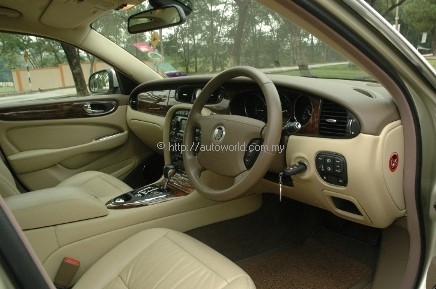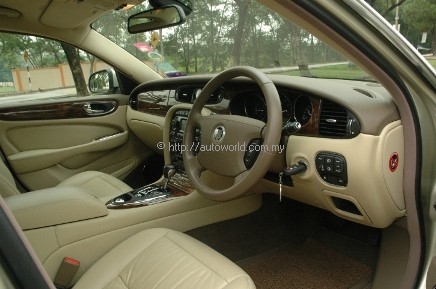Jaguar XJ – Luxurious, & Sporty Performance
Jaguar is usually associated with spaciousness and luxury, stately, mature, powerful, and even regal. The words that connote performance, handling, and agility will probably have question marks after them, as points you would want to have answers to.
Back in the old days, before Mercedes-Benz and BMW became the icons that they are today, if you had a Jaguar, any Jaguar, for that matter, you are considered to have made it. The one model that immediately conjures up visions of performance would be the E-type, but otherwise, Jags (as they are commonly called) are not seen as sporty in any way.
We recently tested the XJ, the current offering by Sisma Auto, the local importers of the Jaguar brand. Big is still in the equation, but that does not necessarily mean heavy any more. The new XJ comes with an aluminium body and low un-sprung weight; which translates into less energy required to move the car, resulting in improved response to demands for power, and relatively low fuel consumption as well.
Everything about the design of the Jaguar, other than the fact that it must remain a large sized luxury saloon, is about making it enjoyable to drive, and maintaining a balance between supple comfort and drivability, providing passenger refinements while delivering driver-focused response. A host of electro-mechanical gizmos are standard fit or options towards these goals.
Air springs and automatic self leveling keeps the XJ composed no matter what the load, while CATS (Computer Active Technology Suspension) adjusts the ride and handling characteristics according to changes in road conditions, including lowering the height in high-speed motorway driving.
Traction control augments the controllability during slippery conditions, and help to keep the drive wheels from spinning during hard acceleration, while Dynamic Stability Control (DSC) keeps the driver on the straight and narrow in case he or she oversteps the limits by smooth (automatic) control of the throttle and brakes.
One feature that is found only in the most exclusive of cars is Adaptive Cruise Control (ACC), a system that allows safe and hassle-free cruising, as it comes with radar to monitor traffic ahead, and adjusts the car’s speed to maintain a safe gap. Unlike other systems that maintain a set distance, it knows the car’s braking distances, and increases the gap according to the speed. When required to, it intervenes by automatically applying the brakes, and no matter how busy the road is, the driver does not have to continuously turn the cruise control on and off. Also incorporated is Forward Alert, which works with ACC, (even when ACC is switched off) to warn the driver to respond by braking. In addition, with or without ACC in action, the XJ has an Automatic Speed Limiter (ASL) can memorise a chosen maximum speed and limit the throttle response if the driver is about to exceed it, at the same time being ‘smart’ enough to override it if the extra speed is needed. And of course, a well appreciated feature would be the Park Control Sensors, placed at the front and rear ends to help you get in or out of tight parking situations.
The Jaguar XJ’s aluminium body is a two-edged sword. Whilst it keeps total weight down, there are those who feel that a steel body is stronger, but Jaguar reassures us that it is built strong, and has the necessary side impact reinforcements, built-in crumple zones, and multiple airbags as supplements. In addition, the powerful Teves braking system is one that drivers will appreciate. It includes ABS anti-lock braking, Electronic Brakeforce Distribution (EBD), and Emergency Brake Assist (EBA).
Even little details like the tyre pressure is monitored through the Tyre Pressure Monitor System (TPMS) that can warn you of a nuisance before it becomes a problem. Inside, the front seats can sense your weight and position, absorbs bumps and guard against whiplash.
Up to now, all that has been said has been to tell you that the Jaguar XJ is one car that is technology-driven in terms of design, and has been put together solely with the driver and safety in mind, and that it is a paradigm shift from what we used to think about Jaguars.
The driving sensation is every bit as good, and although I do bitch a little about the fact that I was given the car for what I consider a very short spate, I do not deny I liked it.
The 3.0 litre V6 petrol engine delivering 238PS at 6,800 RPM and 293 NM of torque at 4,300 RPM, matched to a 6-speed automatic gearbox helps the XJ give a good account of itself. With a body weight of a little under 1.6 tons in Long Wheel Base form,, it accelerates from zero to 100 km/h in 9.0 seconds (as tested, with air-conditioner on), and a top speed of 233 km/h. The gaps between gears are minimal, and the switching is smooth.
The V6 configuration helps to keep the engine smooth too, and just the right amount of exhaust muting keeps the engine note respectable – quiet when cruising, but baring its teeth a little when pushed. Elsewhere, the ride is very comfortable, the suspension feeling supple while being compliant – I would say the design engineers have managed to find the sweet spot between a good ride and great handling. Naturally, the very soft leather seats did their part too, and although I did not go very far (another point to bitch about), I do get the feeling that I will not be too saddle-sore after an extended drive.
Inside, the Jaguar XJ is everything a Jaguar should be – the best materials, with wood inlays in just the right quantity, enough to make it classy without making it like a polished wood furniture shop. This is something Jaguar has always been good at, and it looks like they have done it again. Prices start at RM648,888, which means they are really exclusive.




























